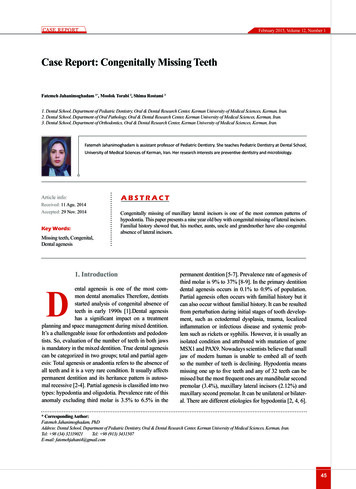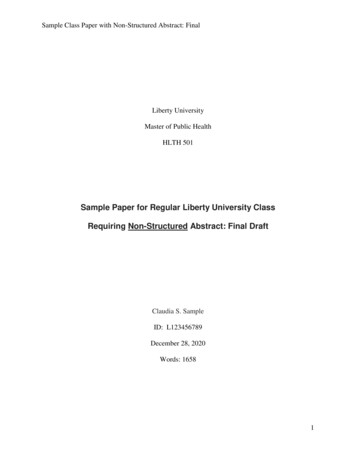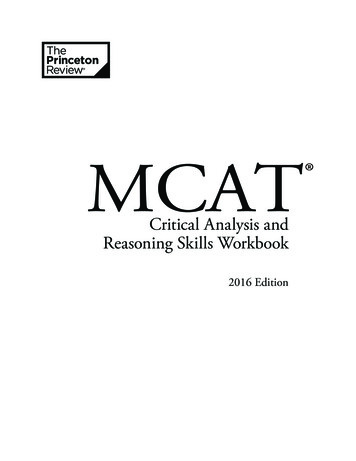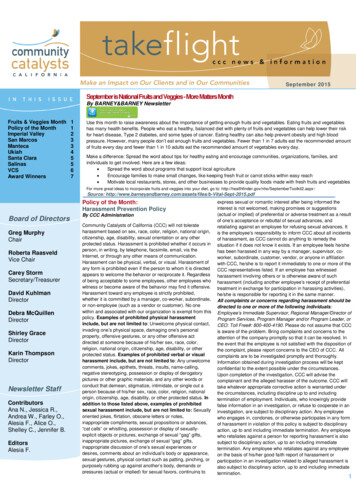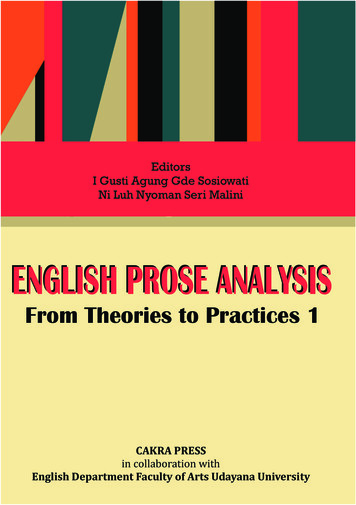
Transcription
EditorsI Gusti Agung Gde SosiowatiNi Luh Nyoman Seri MaliniENGLISH PROSE ANALYSISFrom Theories to Practices 1CAKRA PRESSin collaboration withEnglish Department Faculty of Arts Udayana University
ENGLISH PROSE ANALYSISFrom Theories to Practices 1EditorsI Gusti Agung Gde SosiowatiNi Luh Nyoman Seri MaliniCAKRA PRESSin collaboration withEnglish Department Faculty of Arts Udayana University2017
English Prose Analysis:From Theories to Practices 1EditorsI Gusti Agung Gde SosiowatiNi Luh Nyoman Seri MaliniDesign coverAmanda Ratri YasminLuh Putu Udiani SariPublisher:CAKRA PRESSJalan Diponegoro 256Denpasar, Bali 80114in collaboration withEnglish Department Faculty of Arts Udayana UniversityFirst Edition: January 2017ISBN 978-602-9320-66-4ii
AcknowledgmentIt has been known that there are various kinds ofpeople with various kinds of characters living in this world.There are also various kinds of experiences happening thatthey have to undergo. These kinds of people and experiencesinspire the authors of literature to write about those things.This is very important and useful considering that the life ofhuman beings is very limited and it is expected that they willknow about the world as much as possible. The only possibleand cheapest way of doing it is through reading literarywork. People can have more information, ideas and thefeeling about something without necessarily experiencing itby themselves. The types of literary works produced by thoseauthors can be fiction and non-fiction. The works producedcan be based on the real events, completely imaginativeor the combination of factual and imaginative events. Byreading all the researchers conducted by the students of theFaculty of Arts and Cultures, it is expected that the readerscan improve their life quality considering that there are a lotof moral teaching and human behaviors that will be able tolearn.Great gratititude is extended to those students whohave contributed in the publishing of this compilation whichmostly talked about, characters, characterization, methodsof characterization, and the dimensions creating a humanbeing. Special gratitude is also extended to Ni Luh NyomanSeri Malini who has initiated the idea of producing thiscompilation.Editoriii
Table of ContentsAcknowledgement iiiTable of Contents ivThe Analysis of the Main Character in Doyle’s“The Adventures of Sherlock Holmes: The BoscombeValley Mystery”Amanda Ratri Yasmin 1An Analysis of the Main Characters in Novel “TheStrange Case of Dr. Jekyll and Mr. Hyde” By Robert LouisStevensonNi Putu Dewi Wulan Widyasari 15The Analysis of the Main and the Secondary Characters inAshton’s A Ship To NowhereNi Made Mitha Suandari 27The Analysis of The Main Character Behaviours andCharacterization in Lardner’s “Haircut”Ni Nyoman Bella Ayuniari Astawa 41The Analysis of The Characters in Maupassant’s“The Necklace”Yunita Sari 53The Analysis of Main Character in Dark Brown Dog ShortStory by Stephen CraneNi Made Ari Supin 73iv
The Analysis of Characters and Plot in Draanen’s FlippedLuh Putu Udiani Sari 81Plot Analysis in Short Story “The Adventures of TomSawyer” by Mark TwainI Kadek Dody Mahendra 113A Psychological Analysis of the Main Characters in theNovel “Cirque Du Freak: A Living Nightmare” by DarrenShanNi Putu Diah Antari Suwawi 127A Psychological Analysis of the Main Character in Cabot’s“The Mediator”Putu Intan Teresna Sari 141The Analysis of Psychological Aspect in Chopin’s“The story of An Hour”Ni Nym Claudia Agustina Dewi 153The Analysis of Intrinsic Elements in Hans ChristianAndersen’s “Ib And Little Christine”Ivet Rosenova Belevska 175Stylistic Analysis of The Nightingale and The Rose ShortStory by Oscar WildeI Gusti Ayu Dwi Dharmayanti 191Three Dimensional Aspect of Main Character in A Rose ForEmily by William FaulknerNi Putu Eka Wahyuni 203v
vi
1 The Analysis of the Main Character inDoyle’s “The Adventures of Sherlock Holmes:The Boscombe Valley Mystery”YASMIN, Amanda Ratri1301305057English Department, Faculty of Arts Udayana UniversityEmail address: amandaratriyasmin@yahoo.comAbstractThe study entitled The Analysis of the Main Character in Doyle’s“The Adventures of Sherlock Holmes: The Boscombe Valley Mystery”is aimed at finding out the physiological, sociological andpsychological dimensions of the main character and the methods ofcharacterization used by the author to present the main character inthe short story. There were some theories that are used in this studysuch as the theory about character proposed by Tarigan (1993),theory about characterization proposed by Kenney (1966) andtheory about the dimension of character proposed by Wellek andWarren (1955). The findings are the author only used two methodsof characterization such as discursive method and character oncharacter method and after analyzing Sherlock Holmes as the maincharacter, he is a character who was a well-known private detectivethat not fond of other people but if he already trusted someonehe would be fond of that person, a thoughtful man who did notjump to conclusions easily; he would collect facts and evidenceto support his assumption. He was also a crimes addict yet veryconfident, intelligent, and perceptive man.Keywords: short story, character, characterization, Sherlock Holmes1
S1.INTRODUCTIONhort story like any other prose have specialcharacteristic, in the sense that it has intrinsic elementsand extrinsic elements. Intrinsic elements cover theme,setting, plot, character, point of view, style and tone (Kenney,1966). Character is one of the intrinsic elements which isan important aspect because it conveys the author’s idea,makes the story alive and carries the author’s message thatcan bring various values into human life such as morality,education, and many others. It is important to understandphysiology, psychology, and sociology aspects of thecharacter in order to know the factors that influence thecharacter’s attitude and behaviour. Furthermore, this studyanalyzes the method of characterization used by the authorto present the main character in the short story. How themain character is presented can build such atmosphere thataffects the emotion and the feeling of the readers. From thebackground mentioned above, there are some problems thatcould be analyzed in this study, those are:1. How are the physiological, sociological andpsychological dimensions of the main characters in theshort story?2. What methods of characterization used by the authorto present the main character in the short story?LITERATURE REVIEWThis study was inspired by some previous study suchas a study entitled “Main Character Analysis of Lord of theRing Fellowship of the Ring by J. R. R. Tolkien” (Mertadana:2006). This previous study analyzed the characters in terms2.2
of physiological, sociological, and psychological aspectsbut focused more on the sociological aspect. Anotherprevious study that also inspired this study is “Method ofCharacterization and Three Dimensional Aspects of MainCharacter in Brontë’s Jane Eyre” (Sawitri: 2012). This previousstudy analyzed the three dimensions of character includingthe characterization method used by the author to presentthe characters.3.RESEARCH METHODThe data of this study was taken from the short storyentitled “The Adventures of Sherlock Holmes: The BoscombeValley Mystery” by Sir Arthur Conan Doyle. This short storyis chosen as data source because it can fulfill the need of datain this study.The data was collected through library research thatwas collected through doing some steps, such as: (1) readingand understanding the whole content of the story, (2)identifying the data related to the topic and it was followedby note taking.The collected data was analyzed descriptively based ontheoretical framework. First, the collected data was analyzedby classifying the main character. After being classified, thedata was analyzed in order to determine the physiological,sociological and psychological dimension of the maincharacter based on the theory proposed by Bernhardt, Wellekand Warren (1955). Then, the methods used by author topresent the main character in the short story based on thetheory proposed by Kenney were analyzed.3
4.THEORETICAL FRAMEWORKThere are some theories used in this study such as thetheory about character proposed by Tarigan (1993), theoryabout characterization proposed by Kenney (1966) andtheory about the dimension of character proposed by Wellekand Warren (1955).1.1.CharacterAccording to DiYanni (2001:38) characters are thefictional people, who are part of the action or a literary work.Tarigan (1993:76) divides character into three types based onits function and position:1.1.1. Main CharacterMain character is the central character that can explainthe other characters in the story. As an important figure, itplays an important role in the story.a. Secondary CharacterSecondary character is the character that mostly affectsthe main character.b. Supporting CharacterSupporting character is a character that incidentallysupports the main character by confirming what the maincharacter says or does in the story.1.2.CharacterizationIn presenting characters in the story, the author usessome methods to present and reveal the characters. Accordingto Kenney (1966) there are five methods of characterization,they are:4
1.2.1. Discursive MethodThis kind of characterization takes a direct approachtowards building the character. The author revealed thecharacter by descriptive portrayal or by direct comments (theauthor tells the readers what the personality of the characteris like in straight forward manner).1.2.2. Dramatic MethodIn the dramatic method, the characterization of thecharacter is represented through what they say and howthey say it, their verbal interactions with others and thediscrepancies between their talk and their actions, the actionof the character made who the character is.1.2.3. Character on Character MethodIn the character on character method, the charac terization of the character is represented through what othercharacters say or think about her or him.1.2.4. Contextual MethodIn this method the author reveals information abouta character and their personality through verbal contextthat surrounds that character. The environment in which acharacter lives may cause readers to form certain assumptionsabout the character.1.2.5. Mixing MethodThis method represents the character in the storyby using more than one method (e.g. dramatic method andcharacter on character method). If the author uses dramatic5
and character on character method, the author reveals thecharacter by presenting the character to the audience throughwhat the character say and how they say it, their verbalinteractions with others and the discrepancies between theirtalk and their actions, besides that, the main character’scharacteristics are also revealed by other characters in thestory.1.3.Dimension of CharacterAs Wellek and Warren stated, the author must concernwith the three dimensions in describing the character in orderto create the perfectness of the character.a. Physiological DimensionPhysiology is the study of the human body (Tokay, 1957:1).So, physiological dimension is related to physical condition orappearance of the character which can be observed throughsex, age, and the other physical appearance, such as bodyshape, size, height, skin color, and face.b. Sociological DimensionSociology is the study of human beings and theirinteraction within and between groups of people (Roucekand Warren, 1963:3). So, in literary work, the sociologicaldimension can be connected with economic, political, socialsituations and the interrelationships between all spheres ofhuman activities (Wellek and Warren, 1955:101).c. Psychological DimensionWellek and Warren (1955:75) state that psychology of6
literature means the study of the writer, or the study of thecreative process, or the study of the psychological typesand laws presented within works of literature. According toBernhardt (1953), psychology of literary work can be observedthrough the character. Through psychological approach, thepsychology of character that includes the human motivation,feeling and emotion can be analyzed.5.ANALYSISMain character is the central character that plays animportant role in the story. As the title of the short storyexplicitly stated, the main character is Sherlock Holmes.The story entitled “The Adventures of Sherlock Holmes:The Boscombe Valley Mystery” tells about Sherlock Holmesadventure in solving cases and mysteries. Therefore, Sherlockbecomes the main character because he takes an importantrole in the story.The discussion below concerned with the analysis of thedimensions which build the main character’s characteristicand also how the author characterizes the main character.5.1Physiological DimensionThe physiological dimension can be analyzed throughthe general health, sex, age, appearance including shape ofbody, size, color of skin, etc. The analysis of this dimension isin the following discussion:At the beginning of the story “The Adventures ofSherlock Holmes: The Boscombe Valley Mystery”, Sherlockwas identified as a tall man with gaunt figure, who worea long grey travelling-cloak and close-fitting cloth cap that7
made him even taller and gaunter. This point can be seenfrom this following quotation:“ his tall, gaunt figure made even gaunter and taller byhis long grey travelling-cloak and close-fitting cloth cap.”(Doyle, 1986: 161)In this statement, Sherlock was characterized indiscursive method because the author tried to give theinformation of Sherlock’s appearance through directcomment through the narrator. The author directly statedthat Sherlock is a tall man with gaunt figure according to thequotation above.From physiological dimension, it can be concluded thatSherlock was a tall man with gaunt figure. In finding out thephysiological dimension of Sherlock as the main character,the author used only one method, discursive method.Sociological DimensionThe sociological dimension in the story can be seenfrom many things, which are related to environment andits influence to us such as family, neighborhood, school,the relationship of the character to other characters, andetc. which are the closest group that form a basic behaviorpatterns and attitudes of their members. Social interactionalso concerns social group, social status system, economy,and religion. The analysis of this dimension is presented inthe following discussion:Sherlock looked out for people he cares about. Thispoint can be seen from these following quotations:5.28
“My dear fellow, I know you well. I know the military neatnesswhich characterizes you.” (Doyle, 1986: 162)In this statement, Sherlock was characterized indiscursive method because the author tried to give theinformation of Sherlock’s social relationship with his friendthrough direct explanation. The author stated directly thatSherlock knew his friend well; he knew his friend’s habit thathis friend was always neat because he used to be in military.Sherlock Holmes is a man who is not fond of otherpeople but if he already trusts someone he will be fond ofthat person. This point can be seen from these followingquotations:“It makes a considerable difference to me, having someonewith me on whom I can thoroughly rely.” (Doyle, 1986: 161)In this statement, Sherlock was characterized indiscursive method because the author tried to give theinformation of Sherlock’s social relationship with his friendthrough direct explanation. In the quotation above, theauthor tried to give explanation that Sherlock is glad to beaccompanied by his trustworthy friend. It seems like herather being alone than being accompanied by someone elsewho he cannot rely on. That is why it can be said that he is notof other people except the people he trusts. Sherlock is wellknown private detective from London. This point can be seenfrom these following quotations:“Oh, Mr. Sherlock Holmes! I am so glad that famous detectivelike you have come all the way here.” (Doyle, 1986: 165)9
In this statement, Sherlock was characterized incharacter on character method because the author tried togive the information of Sherlock’s social relationship withpeople around him through other character explanation.The author, by using the other character, gives informationto the reader that Sherlock is a famous detective because heis well-known in different regions that are far enough fromwhere he lives. Other people can recognize him easily that heis Sherlock Holmes, a famous detective.From sociological dimension, it can be concluded thatSherlock was a well-known private detective who is not fondof other people but if he already trusts someone he will befond of that person. In finding out the sociological dimensionof Sherlock, the author used two methods namely discursivemethod and character on character method.5.3Psychological DimensionWhen analyzing the psychological dimension of acharacter, there are various aspects to be concerned on. Theyare human motivation included appetites, wants, emotions,feeling and attitude, and social motives, and also feelings andemotions. The analysis of this dimension is in the followingdiscussion:Sherlock is a thoughtful man. He did not jump toconclusions easily; he would collect facts and evidence tosupport his assumption. This point can be seen from thesefollowing quotations:“I shall take nothing for granted until I have the opportunityof looking personally into it.” (Doyle, 1986: 161)10
“The London press has not had very full accounts. I have justbeen looking through all the recent papers in order to masterthe particulars.” (Doyle, 1986: 161)“‘Circumstantial evidence is a very tricky thing,’ answeredHolmes thoughtfully.” (Doyle, 1986: 162)Those statements above show that Sherlock wascharacterized through discursive method because the authortried to give the information of Sherlock’s psychologicalcondition through direct explanation. According to thequotations above, Sherlock will not make any assumptionbefore he gets some facts or evidence to proof his assumption.The author also directly stated that he will say somethingthoughtfully.Sherlock Holmes is a very confident, intelligent andperceptive man. This point can be seen from this followingquotation:“I very clearly perceive that in your bedroom the window isupon the right-hand side ” (Doyle, 1986: 162)In this statement, Sherlock was characterized indiscursive method because the author tried to give theinformation of Sherlock’s psychological condition throughdirect comment that he is able to know facts of someoneor something without being told about it. Sherlock is veryintelligent; he can know some information without anyonetold him. He is also a confident man; he always says hisassumption confidently when he has the proofs.Sherlock Holmes is a crimes addict; he loves to workunofficially to uncover crimes with his own point of view.11
This point can be seen from this following quotation:“I knew your energetic nature, and that you would not be happyuntil you had been on the scene of the crime.” (Doyle, 1986: 164)In this statement, Sherlock was characterized incharacter on character method because the author tried togive the information of Sherlock’s psychological condition,through another character explanation. The author makesSherlock a character that was addicted to crime. He washappy to see crime scene and collected facts and evidencesto proof his assumption later on. The fact that he was usuallyable to get some proof that the police unable to; can changethe point of view of some cases. This was a strange behaviour,because people usually do not like to go to the crime scene.From psychological dimension, it can be concludedthat Sherlock was thoughtful man who did not jump toconclusions easily; he would collect facts and evidence tosupport his assumption. He was a crimes addict yet veryconfident, intelligent, and perceptive man. In finding outpsychological dimension of Sherlock as the main character,the author used two methods, namely discursive method andcharacter on character method.6.CONCLUSIONBased on the analysis and discussion of the problemsmentioned earlier, some conclusions can be drawn as follows:In order to figure out the character of SherlockHolmes as the main character, there are three dimensions ofcharacter that are analyzed. From physiological dimension,Sherlock was a tall man with gaunt figure. From sociological12
dimension, Sherlock was a well-known private detectivewho was not fond of other people but if he already trustedsomeone he would be fond of that person. From psychologicaldimension, Sherlock was a thoughtful man who did not jumpto conclusions easily; he would collect facts and evidence tosupport his assumption. He was a crimes addict yet veryconfident, intelligent, and perceptive man.In this story, the author only used two methods ofcharacterization those are: discursive method and characteron character method.REFERENCESBernhardt, Karl S. 1953. Practical Psychology. Canada: Mc.Graw-HillBook Company,Inc.DiYanni, Robert. 2001. Literature Reading Fiction, Poetry, and Drama.New York: Mc.Graw-Hill Book Company, Inc.Doyle, Sir Arthur Conan. 1986. Sherlock Holmes: The Complete Novelsand Stories, Vol. 1. New York: Bantam ClassicsHornby, A.S. 2010.Oxford Advanced Learner’s Dictionary EighthEdition. Oxford: Oxford University PressKenney, William. 1966. How to Analyze Fiction. New York: MonarchPressMertadana, I Made Meyge. 2006. Main Character Analysis of Lord ofthe Ring Felllowship of the Ring by J. R. R. Tolkien.Denpasar:Udayana UniversityRoucek, Joseph S. and Rolland L. Warren. 1963. Sociology AnIntroduction. New Jersey: Littlefields, Adams, and Co PatersonSawitri, Komang Alit. 2012. Method of Characterization and ThreeDimensional Aspects of Main Character in Brontë’s Jane Eyre.Denpasar: Udayana UniversityTarigan, Henry Guntur. 1984. Prinsip-Prinsip Dasar Sastra. Bandung:13
Angkasa Bandung.Wellek, Rene, and Austin Warren. 1955. The Theory of Literature.London: Lowe & Brydone Ltd.14
2An Analysis of the Main Characters in Novel“The Strange Case of Dr. Jekyll and Mr.Hyde” By Robert Louis StevensonWIDYASARI, Ni Putu Dewi Wulan1301305077English Department, Faculty of Arts Udayana UniversityEmail address: Wulanwidyasari8@gmail.comAbstractThe article entitled An Analysis of the Main Characters in Novel“The Strange Case of Dr. Jekyll and Mr. Hyde” By Robert LouisStevenson is aimed at finding out the main characters. The theoryused in this study is proposed by Edgar V. Roberts (1964: 41).Character is a general description of the man who determines humanideas, words and style through dialogue, action, and commentaryabout the character. This study used library research to collect thedata by note taking. Qualitative was used in the analysis and it wasdescriptively presented.Keywords: Character, Main CharacterI1.INTRODUCTIONn our lives there are many realities that can affect humanlife. Every event happens to create stress on our lives. Theinfluence of the reality of this life will be better or worsedepending on how human beings accept it. The example ofthe reality that can affect a person’s behavior is loss of parents.Indirectly, this will be the cause of the man who suffers tochange. Whether it is a good change for the better or even for15
the worse depends on how humans accept that reality. Associal beings we certainly need the help from others, supportfrom others to get through the tough times.Short story, novel, drama and poetry are literary workswhich are created based on author’s situations, experiencesor imagination. Literature is a piece of writing that describesthe authors’ thoughts and feelings in the reality of sociallife as a reflection of the phenomena occurring aroundthem. Wellek & Warren (1971:3) say, “Literature is themirror of human life that portrays human feeling, thought,imagination and perception which can be viewed based onpersonal judgment.” Literature constitutes the imaginativeact from the human’s imagination and interpreting lifeexperiences. Author writing a novel is not merely to givefeelings of pleasure to the readers, but also want to convey amessage of understanding human life through the explanationof the events and actions of the characters in the novel. Andthrough a novel, the author also describes that everyone hasdifferent characters, such as temperamental, humorous andpossessive etc.According to Reaske (1966: 5) in t “How to AnalyzeDrama”, a literary work can depict life by presenting a varietyof action and dialogue between the characters. Disposition isone important element in special literary works. According toHofman, in The Encyclopedia of Americans, characterizationis one of the attitudes, behaviors or habits in imaginingsomeone to make them credible to the readers.According to Glorier (1977: 291), the characterizationis a unique characteristic of fiction such as short story, novel,drama, and poetry. Character contained in the novel may16
also show changes which is significantly influenced by thenarrative, so that each character has the power to dominatethe story as a whole.“The Strange of Dr.Jekyll and Mr.Hyde” is one of theworks of Robert Louis Stevenson that was published in 1866by eBook Planet in the USA. “The Strange Case of Dr. Jekylland Mr. Hyde” describes Dr. Jekyll as the one who who hasmore than one personality or in the figure of Dr. Jekyll thereis another figure, named Mr. Hyde. The second personality isthe opposite, where the figure of Dr. Jekyll is a good figure toeveryone, while the figure of Mr. Hyde is very nasty.The author choses this topic because the main characterin the novel “The Strange Case of Dr. Jekyll and Mr. Hyde”is very interesting to analyze since it has more than onepersonality or multiple personalities in one person.2.LITERATURE REVIEWA thesis titled “An Analysis of Main Characters inStephenie Meyer’s novel: New Moon” by Umi Fauziahdiscusses the key figures contained in the novel New Moonby Stephenie Meyer. The author found the main charactershave different characteristics and have different propertiesas well. The author used library research method by readingsome English grammar books as references to informationthat supports this title and also search from the internet.Thus the characteristics and properties of each character inthe novel can be found.3.RESEARCH METHODThe data for this article was taken from the enternet17
eof-Dr-Jekyll). It is a novel entitled “The Strange Case of Dr.Jekyll and Mr. Hyde” written by Robert Louis Stevenson. Itwas originally published in 1866 by eBook Planet in the USA.This study used library research to collect the data bynote taking. The process of analysis was divided into severalsteps. The first step was reading the short story repeatedlyand intensively to understand the content of the short story.Then, the second step was reading the theory book andbrowsing to the internet, in order to get more informationthat is relevant to the topic.The author used descriptive qualitative researchmethod with purposive sampling method in taking thesample data. Qualitative was used in the analysis and it wasdescriptively presented. In analyzing the data, there are somesteps. The steps are reading, comprehending and findingimportant details of the data, analyzing the characteristic ofthe main characters in novel “The Strange Case of Dr. Jekylland Mr. Hyde” written by Robert Louis Stevenson.4.THEORETICAL FRAMEWORKIn conducting this study the theory that Edgar V.Roberts (1964: 41) was used. It says that the character is ageneral description of the man who determines human ideas,words and style through dialogue, action, and commentaryabout the character, he suggested four special ways to getinformation about the characters, namely:a. What the character said about himself.b. What the character did.c. What is the other character’s opinion about the character18
that being analyzed.d. What the author said about the character.ANALYSISHere’s the characteristics owned by the main charactersin the novel “The Strange Case of Dr. Jekyll and Mr. Hyde”by Robert Louis Stevenson”:5.5.1. Dr. Jekyll5.1.1. Arrogant“I was born in the year 18— to a large fortune, endowed besideswith excellent parts, inclined by nature to industry, fond of therespect of the wise and good among my fellowmen, and thus, —might have been supposed, with every guarantee of an honourableand distinguished future.” (Stevenson, 1993: 48)The quotation above illustrates that Dr. Jekyll is a personborn in a wealthy family is regarded as a good luck. As Dr.Jekyll, representing the upper class society with abundantwealth and intelligence as well as its higher education, makeshim highly respected in society in Victorian times in England.In order to keep his pride, he should be able to keep himselffrom despicable acts such as killing or stealing.5.1.2. Liar“. I [Dr. Jekyll] swear to God I will never set eyes on him again. Ibind my honor to you that I am done with him in this world.”Liar is also one of the characteristic owned by Dr.19
Jekyll, as contained in the following passage, he tried to coverup the truth about who Mr. Hyde is when the authoritiesinvestigated some strange events that occurred in Londonwhere Dr. Jekyll lives.5.1.3.Ambitious“I had learned to dwell with pleasure, as a belovedday-dream. On the thought of the separation of theseelements. If each, I told myself, could but be housed inseparate identities, life would be relieved of all that wasunbearable; the unjust might go his way, delivered from theaspirations and remorse of his more upright twin; and themst could walk steadfastly and securely on his upward path,domg the good things in which be found his pleasure, andno longer exposed to disgrace and penitence by the handsof this extraneous evil. It was
“The Adventures of Sherlock Holmes: The Boscombe Valley Mystery” is aimed at finding out the physiological, sociological and psychological dimensions of the main character and the methods of characterization used by the author to present the main character in the short st



